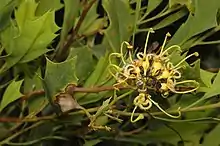| Grevillea angulata | |
|---|---|
 | |
| Grevillea angulata in the Hunter Region Botanic Gardens | |
| Scientific classification | |
| Kingdom: | Plantae |
| Clade: | Tracheophytes |
| Clade: | Angiosperms |
| Clade: | Eudicots |
| Order: | Proteales |
| Family: | Proteaceae |
| Genus: | Grevillea |
| Species: | G. angulata |
| Binomial name | |
| Grevillea angulata | |
Grevillea angulata is a species of flowering plant in the family Proteaceae and is endemic to the Top End of the Northern Territory. It is a spreading to erect shrub with pinnatifid or toothed leaves and cream-coloured flowers.
Description
Grevillea angulata is a spreading to erect shrub that typically grows to a height of 1–2.5 m (3 ft 3 in – 8 ft 2 in), its foliage covered with fine hairs pressed against the surface. The leaves are oblong to elliptic in outline, 55–110 mm (2.2–4.3 in) long and 24–40 mm (0.94–1.57 in) wide and pinnatifid or with seven to twenty-nine pointed lobes. The flowers are arranged in leaf axils or on the ends of branches on a rachis 15–30 mm (0.59–1.18 in) long. The flowers are green in the bud stage but open cream-coloured and covered with white hairs, the pistil 18–24 mm (0.71–0.94 in) long with a white to cream-coloured, green-tipped style. Flowering mainly occurs from March to September and the fruit is a glabrous follicle 10–14 mm (0.39–0.55 in) long.[3][4]
Taxonomy
Grevillea angulata was first formally described in 1830 by Robert Brown in his Supplementum primum prodromi florae Novae Hollandiae.[5][6] The specific epithet (angulata) means "angular" or "angled".[7]
Distribution and habitat
This grevillea grows in shrubland and woodland near creeks or in rocky places, sometimes near the coast, and is found in north-western Arnhem Land and on some nearby off-shore islands in the Top End of the Northern Territory.[3][4]
Conservation status
Grevillea angulata is listed as "Least Concern" on the IUCN Red List of Threatened Species. It is widely distributed with a presumed large overall population and does not appear to face any substantial threats, either currently or in the near future.[1]
References
- 1 2 Keighery, G.; Olde, P. (2020). "Grevillea angulata". IUCN Red List of Threatened Species. 2020: e.T112645927A113307651. doi:10.2305/IUCN.UK.2020-2.RLTS.T112645927A113307651.en. Retrieved 20 December 2023.
- ↑ "Grevillea angulata". Australian Plant Census. Retrieved 2 January 2022.
- 1 2 "Grevillea angulata". Australian Biological Resources Study, Department of Agriculture, Water and the Environment: Canberra. Retrieved 2 January 2022.
- 1 2 "Grevillea angulata". Northern Territory Government. Retrieved 2 January 2022.
- ↑ "Grevillea angulata". APNI. Retrieved 2 January 2022.
- ↑ Brown, Robert (1830). Supplementum primum prodromi florae Novae Hollandiae. London. p. 24. Retrieved 2 January 2022.
- ↑ Sharr, Francis Aubi; George, Alex (2019). Western Australian Plant Names and Their Meanings (3rd ed.). Kardinya, WA: Four Gables Press. p. 133. ISBN 9780958034180.
